 |
 |
 |
 |
 |
 |
 |
 |
 |
 |
 |
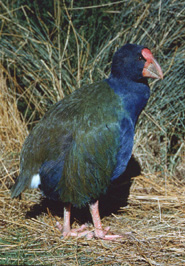
|
Birds Takahe, Kiwi Kakapo, Penguin Teal, Moa, Wren |
|
||||||||
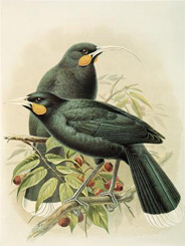 |
Wattlebirds Huia Kokako Saddleback |
| Gigantism in insects | |
|
|
Weta Giant worms |
|
||||
 |
First tuatara nest found in 200 years
Tuatara to get new lease on life as rats wiped out
Tuatara take first steps to comeback
New Zealand reptile in climate peril
Tuatara at home on island
Island tuatara bounce back |

|

|
|
The tuatara is the world's sole remaining beak-headed reptile of the Rhynchocephalia Order. This group became extinct in all other places on Earth, but the tuatara has survived in New Zealand for 200 million years. The tuatara is one of the most unevolved and oldest animals living in the world today. The tuatara resembles an ordinary lizard in appearance, but it is so radically different, it is classified in its own order, as well as its own family. It is characterised by a second bony bridge in its skull which is also found in crocodilians, but is lost in lizards and snakes. |
|
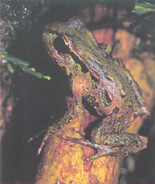 |
As with Leiopelma frogs (left), tuatara evolved in
the ancient Triassic world of Gondwana, and survived the Cretaceous period when
the dinosaurs died out. They have both been isolated on New Zealand islands for 80 million
years. |
|
The absence of a pairing organ, and an immovable fixing of the quadrate bone to the skull, also differentiate tuatara from lizards. These primitive features extend back to prehistoric "stem reptiles" of the Permian and Triassic period, from which all reptiles are believed to have descended. An unusual feature is a third pineal eye which has a retina and a rudimentary lens, and is connected to the brain by a nerve. It is apparent in infants, but is covered by opaque scales in adults, so it is unknown whether the eye serves any function. Females only mate every four years, but males wish to mate every year, which causes frustration, and considerable fighting amongst the males for partners. Eggs take four years to develop in the female, which is longer than any reptile. As many as 19 eggs are laid in a shallow depression in the ground outside the burrow, and take a full year to hatch. The gender of the hatchling is determined by the temperature of the ground. Tuatara live for 60 to 100 years. |
|
 |
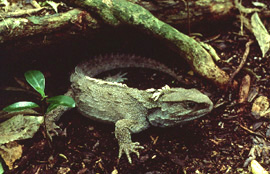
A really cool character ...Tuatara reach a peak of activity when their body temperature is 12 to 17 degrees centigrade, the lowest warmth requirement of any reptile. This is possibly the reason they have been able to survive for so long in New Zealand's temperate climate. Other reptiles are active when their body temperature is 25 to 38 degrees centigrade. Other remarkable traits of tuatara are that they take a breath of air just once every hour, and do not drink water. Tuatara are primarily nocturnal, but like to spend part of the day basking in the sun outside their burrow. They come out at night to feed on insects such as wetas, worms, snails, and just about anything else. Dinner sometimes even includes its own young. Home is below ground in burrows forming a labyrinth of tunnels, that are sometimes shared with shearwaters and petrels. In the spring tuatara will occasionally dine on the seabird eggs or chicks. |
|
International Threatened & Endangered Listings 2000 IUCN Red List of Threatened Species Tuatara Sphenodon guntheri Vulnerable United States Threatened and Endangered Species, Foreign Listed Species Tuatara Sphenodon punctatus Endangered Brothers Island Tuatara Sphenodon guntheri Endangered Tuatara Sphenodon punctatusTuatara were once commonly found on both of New Zealand's mainland islands, but are now only on offshore islands. Sphenodon punctatus which is more common, has brown and white skin. It is on northern islands in the Hauraki Gulf and Coromandel Coast, with a subspecies on islands in the Cook Strait. Tuatara can be seen sunbathing next to trails on Tiritiri Matangi Island, since 60 were moved to the reserve from the Mercury Islands in 2003. An egg nest was found in December 2003, so the first hatchlings on the island may appear in early 2005. Brothers Island tuatara Sphenodon guntheriSphenodon guntheri is endemic to Brothers Island, and is colored differently with olive skin with white spots. There are presently only 400 of this species remaining. Photo and illustration credit |
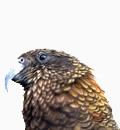
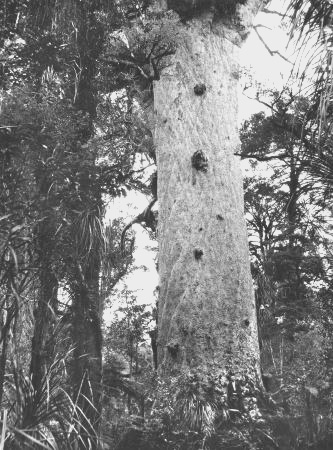
 See Leiopelma frogs
See Leiopelma frogs Return to living fossils -
native frogs & snails
Return to living fossils -
native frogs & snails